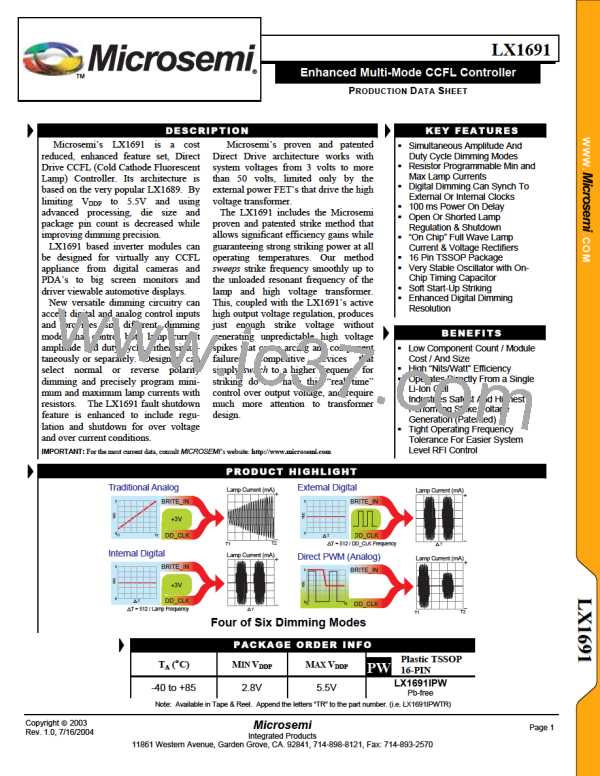LX1691
Enhanced Multi-Mode CCFL Controller
®
TM
PRODUCTION DATA SHEET
DETAILED DESCRIPTION (CONTINUED)
LX1691 Operation
Strike Mode
Four operating modes: Power On Delay, Strike, Run, and Fault
Entered from Power On Delay, or upon an ENABLE sequence.
modes are employed by the LX1691. Upon power up or ENABLE Control of the Ramp Generator frequency is switched to the DAC
going true, Power On Delay is automatically invoked. output. Frequency is increased from its normal run value to up to
Immediately after termination of Power On Delay, or ENABLE three times that value for up to 6 sweeps If while strike frequency is
going true, strike mode is entered. After a successful strike, e.g., sweeping, the set points at OV_SNS and / or OC_SNS are detected,
lamp is ignited, run mode is entered. If ignition is unsuccessful, or strike frequency will freeze at the present value until either the lamp
if the lamp extinguishes while running, Fault mode is entered. strikes or the timeout is reached. Strike Mode is terminated by
Lamp ignition is determined by monitoring the lamp current reaching 6 sweep counts or by detecting lamp ignition. If strike is
feedback voltage at pin I_SNS. Lamp current cycles are counted successful, Run Mode is entered. If unsuccessful, Fault mode is
from the beginning of Strike mode. If 4 or more complete cycles entered.
occur the lamp is declared ignited. If less than 4, the lamp is
Run Mode
considered not ignited and Strike mode continues until ignition is
Entered only by detection of a successful Strike. Frequency
detected or strike time out (approximately 350ms) is reached.
control is immediately switched to a fixed reference that sets the
After run mode is entered lamp current pulse count is sampled programmed run frequency. The lamp current cycle counter is
several times a second to determine that the lamp has not monitored to insure at least 4 current cycles received during each
inadvertently extinguished. If lamp current pulses are counted in period. If less than 4, the lamp is considered extinguished and the
each sample, Run mode is maintained. Otherwise, Fault mode is Fault Mode is entered.
entered. Strike mode can be entered only once for each on/off cycle
Fault Mode
of either VDDP or ENABLE. This insures that even intermittent
Fault Mode may be entered from either Strike or Run Mode as
lamp failures cannot cause the module to continuously output
described above. In Fault Mode, the A & B output buffers are
forced low. Fault mode may be cleared by cycling ENABLE off
maximum strike voltage.
During strike, operating frequency is swept from the normal run then on, or by removing and applying VDDP
value approximately to 3X run frequency. This will excite the
unloaded resonant frequency of the transformer and lamp load to
.
Design Procedure
generate the required lamp striking voltage. If the lamp has not
ignited after about 350mS, a fault is declared and the A & B
outputs are shut off.
Selecting the I_R resistor value
This resistor determines the value of several internal reference
currents that control timing. It must be chosen first, and will be in
the range of 40 to 120K ohms. We use an 80.6K, 1% low TCR
value in our designs to set nominal lamp current frequency to
65kHz. The output frequency is approximated by the following
If while strike frequency is sweeping, the over voltage set point
at OV_SNS is detected or overcurrent voltage set point at
OV_SNS is deteted the, strike frequency will hold at the frequency
value until either the lamp strikes or the timeout is reached. This
causes maximum strike potential to be continuously impressed
across the lamp for the entire strike period.
formula: RI_R = 5.24E9 / FLAMPOUT/HZ
.
Driving the BRITE_IN Input
The BRITE_IN input circuitry includes on-chip active voltage
clamps that ignore input voltage greater than 2.0V. Input
impedance is very high so it can also be driven from a 100K
potentiometer with no offset error. BRITE_IN can be a DC voltage,
or a higher frequency externally filter PWM The BRITE_IN input
has a linear active range between 0.0 and 2.0V
Also, if while strike frequency is sweeping, the over current set
point at OC_SNS is detected, strike frequency will hold at the
present value until either the lamp strikes or the timeout is reached.
This insures short circuit current regulation will be maintained, thus
enabling UL fault requirements to be easily met at the inverter
module level.
The only way to re-initiate the strike process is to either cycle
VDDP or ENABLE off and on.
If ignition is successful, ramp frequency immediately returns to
its programmed run value.
Power ON Delay Mode
All functions are activated except that AOUT and BOUT are
inhibited. Delay is in the 100mSec range and is determined by a
counter. Power on delay is activated at every VDDP power up
sequence and ENABLE sequence.
Copyright © 2003
Rev. 1.0, 7/16/2004
Microsemi
Page 11
Integrated Products
11861 Western Avenue, Garden Grove, CA. 92841, 714-898-8121, Fax: 714-893-2570

 MICROSEMI [ Microsemi ]
MICROSEMI [ Microsemi ]